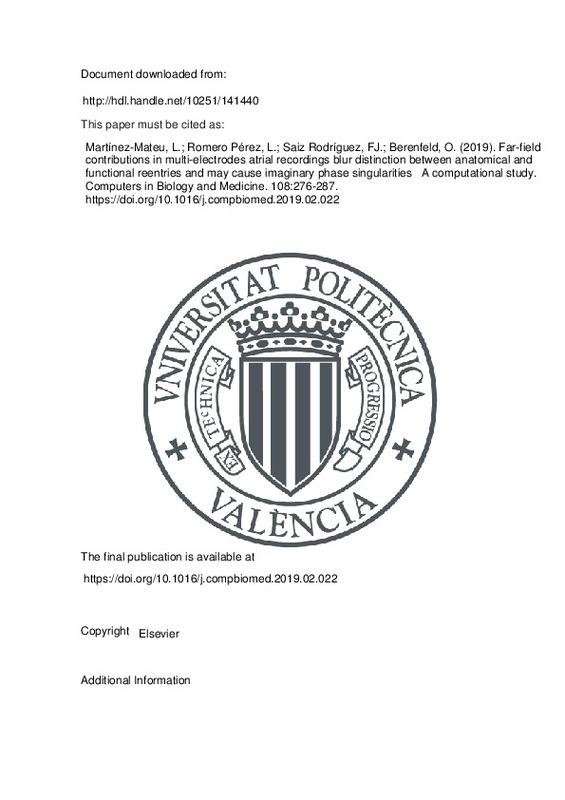JavaScript is disabled for your browser. Some features of this site may not work without it.
Buscar en RiuNet
Listar
Mi cuenta
Estadísticas
Ayuda RiuNet
Admin. UPV
Far-field contributions in multi-electrodes atrial recordings blur distinction between anatomical and functional reentries and may cause imaginary phase singularities A computational study
Mostrar el registro sencillo del ítem
Ficheros en el ítem
| dc.contributor.author | Martínez-Mateu, Laura
|
es_ES |
| dc.contributor.author | Romero Pérez, Lucia
|
es_ES |
| dc.contributor.author | Saiz Rodríguez, Francisco Javier
|
es_ES |
| dc.contributor.author | Berenfeld, Omer
|
es_ES |
| dc.date.accessioned | 2020-04-24T07:13:32Z | |
| dc.date.available | 2020-04-24T07:13:32Z | |
| dc.date.issued | 2019 | es_ES |
| dc.identifier.issn | 0010-4825 | es_ES |
| dc.identifier.uri | http://hdl.handle.net/10251/141440 | |
| dc.description.abstract | [EN] Background Atrial fibrillation (AF) is the most common cardiac arrhythmia and the most important cause of embolic stroke, requiring new technologies for its better understanding and therapies. Recent approaches to map the electrical activity during AF with multi-electrode systems aim at localizing patient-specific ablation targets of reentrant patterns. However, there is a critical need to determine the accuracy of those mapping systems. We performed computer simulations as a numerical approach of systematically evaluating the influence of far-field sources on the electrical recordings and detection of rotors. Methods We constructed 2 computer models of atrial tissue: (i) a 2D sheet model with varying non-active cells area in its center, and (ii) a whole realistic 3D atrial model. Phase maps were built based on the Hilbert transform of the unipolar electrograms recorded by virtual 2D and 3D multi-electrode systems and rotors were tracked through phase singularities detections. Results Analysis of electrograms recorded away from the 2D atrial model shows that the larger the distance between an electrode and the tissue model, the stronger the far-field sources contribution to the electrogram is. Importantly, even if an electrode is positioned in contact with the tissue, the electrogram contains significant contributions from distal sources that blur the distinction between anatomical and functional reentries. Moreover, when mapping the 3D atrial model, remote activity generated false phase singularities at locations without local reentrant excitation patterns. Conclusions Far-field contributions to electrograms during AF reduce the accuracy of detecting and interpreting reentrant activity. | es_ES |
| dc.description.sponsorship | This work was supported in part by Programa Prometeu de la Conselleria d'Educacio, Formacio I Ocupacio de la Generalitat Valenciana, award number PROMETEU/2016/088; Plan Estatal de Investigacion Cientifica y Tecnica y de Innovacion 2013-2016 del Ministerio de Economia, Industria y Competitividad of Spain, Agencia Estatal de Investigacion and the European Commission (European Regional Development Funds - ERDF -FEDER), award number DPI2016-75799-R; The National Heart, Lung, and Blood Institute grant ROl-HL118304; the Gelman Award from the Cardiovascular Division at the University of Michigan; and the Coulter Program Award from the Dept. of Biomed Eng. at the University of Michigan. | es_ES |
| dc.language | Inglés | es_ES |
| dc.publisher | Elsevier | es_ES |
| dc.relation.ispartof | Computers in Biology and Medicine | es_ES |
| dc.rights | Reconocimiento - No comercial - Sin obra derivada (by-nc-nd) | es_ES |
| dc.subject | Mapping | es_ES |
| dc.subject | Electrogram | es_ES |
| dc.subject | Phase analysis | es_ES |
| dc.subject | Far-field | es_ES |
| dc.subject | Rotors | es_ES |
| dc.subject | Reentry | es_ES |
| dc.subject.classification | TECNOLOGIA ELECTRONICA | es_ES |
| dc.title | Far-field contributions in multi-electrodes atrial recordings blur distinction between anatomical and functional reentries and may cause imaginary phase singularities A computational study | es_ES |
| dc.type | Artículo | es_ES |
| dc.identifier.doi | 10.1016/j.compbiomed.2019.02.022 | es_ES |
| dc.relation.projectID | info:eu-repo/grantAgreement/NIH//R01HL118304/ | es_ES |
| dc.relation.projectID | info:eu-repo/grantAgreement/GVA//PROMETEO%2F2016%2F088/ES/MODELOS COMPUTACIONALES PERSONALIZADOS MULTI-ESCALA PARA LA OPTIMIZACION DEL DIAGNOSTICO Y TRATAMIENTO DE ARRITMIAS CARDIACAS (PERSONALISED DIGITAL HEART)/ | es_ES |
| dc.relation.projectID | info:eu-repo/grantAgreement/MINECO//DPI2016-75799-R/ES/TECNOLOGIAS COMPUTACIONALES PARA LA OPTIMIZACION DE TERAPIAS PERSONALIZADAS DE PATOLOGIAS AURICULARES Y VENTRICULARES/ | es_ES |
| dc.rights.accessRights | Abierto | es_ES |
| dc.contributor.affiliation | Universitat Politècnica de València. Departamento de Ingeniería Electrónica - Departament d'Enginyeria Electrònica | es_ES |
| dc.description.bibliographicCitation | Martínez-Mateu, L.; Romero Pérez, L.; Saiz Rodríguez, FJ.; Berenfeld, O. (2019). Far-field contributions in multi-electrodes atrial recordings blur distinction between anatomical and functional reentries and may cause imaginary phase singularities A computational study. Computers in Biology and Medicine. 108:276-287. https://doi.org/10.1016/j.compbiomed.2019.02.022 | es_ES |
| dc.description.accrualMethod | S | es_ES |
| dc.relation.publisherversion | https://doi.org/10.1016/j.compbiomed.2019.02.022 | es_ES |
| dc.description.upvformatpinicio | 276 | es_ES |
| dc.description.upvformatpfin | 287 | es_ES |
| dc.type.version | info:eu-repo/semantics/publishedVersion | es_ES |
| dc.description.volume | 108 | es_ES |
| dc.relation.pasarela | S\387530 | es_ES |
| dc.contributor.funder | Generalitat Valenciana | es_ES |
| dc.contributor.funder | National Institutes of Health, EEUU | es_ES |
| dc.contributor.funder | University of Michigan | es_ES |
| dc.contributor.funder | National Heart, Lung, and Blood Institute, EEUU | es_ES |
| dc.contributor.funder | Biomedical Engineering Department, University of Michigan | es_ES |
| dc.contributor.funder | Ministerio de Economía y Competitividad | es_ES |







![[Cerrado]](/themes/UPV/images/candado.png)

